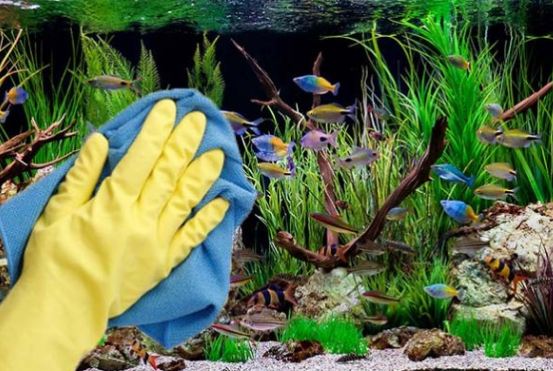Aquarium Cleaning – Pet fish health depends on clean water and a clean tank or aquarium. Regular cleaning, every fortnight, should be your policy except in special circumstances. This method allows you to clean the tank without removing the fish, though at longer intervals that should be considered. To do this, a siphon to change the water at the later stages is a worthwhile investment.

The preferred procedure is then as follows:
- Switch off and unplug any appliances such as lighting, filters, heaters, etc.
- It is not necessary to remove the fish. The water will be changed in stages; this method involves less upheaval for the inhabitants.Only use dechlorinated water to clean the tank. Tap water that has stood for at least a day and ideally two, is satisfactory.
- Remove algae from all surfaces, including plants, ornaments, internal fittings, etc., using a lighter form of wipe or scraper for the sides of acrylic tanks as they are more easily scratched than glass tanks.
- Wash filters within the water in the tank if possible. Replace the carbon at least every second time you clean the tank if carbon is being used to reduce tank odors.
- Clean the gravel, usually by fishing it out, washing it (again in dechlorinated water if possible) and by wiping or brushing it with implements that have not been contaminated with substances dangerous to your fish. This stage could be partly combined with the first stage of water changes of the next step, to make it easier to do.
- Cleaning the aquarium up to this point in the process will have added more dirt to the water temporarily, so it is at this stage that the water should be cleaned. If the water is in a fairly normal state of pH and nitrate, it can be changed say 20% at a time. However, if it is outside the required range, then up to half should be changed in a single stage. The most efficient and tidiest way to change the water is to use a siphon designed for the purpose.
- Refill the tank up to the required level with dechlorinated water, ensuring that the temperature of the new water is close to that in the tank; some care about this will be required with more climate-susceptible fish.
- Reconnect and switch on the appliances.
- Re-check the pH and nitrate of the water, plus the salinity if a saltwater aquarium is being used, and adjust as necessary to return your fish and aquarium to a clean environment.
Read This Article: Aquarium Algae Fish Feeding Pets Tips






